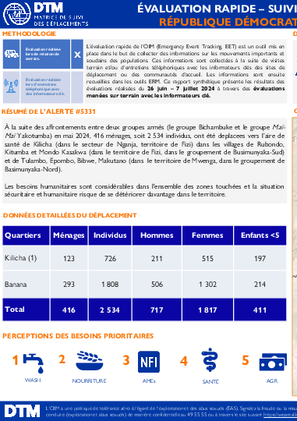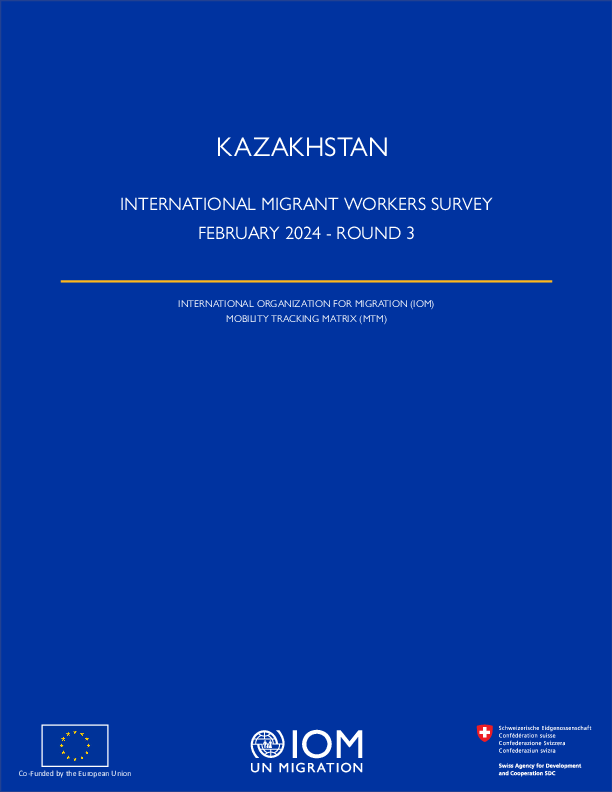-
Countries
-
Data and Analysis
-
Special Focus
-
Crisis Responses
Internal displacement
Domain host
displacement.iom.int

Contact
iomtashkent@iom.int
Language
English
Location
Uzbekistan
Period Covered
Jan 01 2024
Mar 31 2024
Activity
- Flow Monitoring Survey
- Mobility Tracking
This report presents the latest available data on recent trends concerning migration issues in Uzbekistan, drawing upon data available for January-March 2024 and providing relevant comparisons on migration trends based on information from national and international datasets that are available to the public. The report includes recent major global and regional events that are significantly impacting the migration situation in the country. The ongoing Russian invasion of Ukraine has impacted traditional migration corridors in the region since 2022. Furthermore, the impact of the changing labour migration flows, the increase of migration related to climate change, the growing urbanization process, the social-economic circumstances, increased irregular migration trends and other major events are also described as main contributing factors of the human mobility and migratory movements in the given period in the country.

Contact
iomastana@iom.int iomalmaty@iom.int
Language
English
Location
Kazakhstan
Period Covered
Jan 01 2024
Jan 31 2024
Activity
- Mobility Tracking
- Baseline Assessment
Базовая оценка мобильности была проведена в 10 областях, включая 3 города Республиканского значения - г. Шымкент, г. Алматы, г. Астана, а также 1245 сёл, в период с декабря 2023г. по январь 2024г. Во время оценки, было проинтервьюировано 2303 ключевых информаторов. По оценкам ключевых информаторов, 639 799 международных трудящихся мигрантов проживали в исследуемых локациях с 2020г. по 2023г.. Также, было выявлено 41 574 внутренних мигрантов в 10 областях, а 10 544 граждан Казахстана проживали за границей в качестве эмигрантов. К тому же, было выявлено 6005 возвратных мигрантов в исследуемых областях.

Contact
DTM Support — iomdrcdtm@iom.int
Language
French
Location
Democratic Republic of the Congo
Period Covered
Jul 01 2024
Jul 07 2024
Activity
- Mobility Tracking
- Event Tracking
L’évaluation rapide de l’OIM (Emergency Event Tracking, EET) est un outil mis en place dans le but de collecter des informations sur les mouvements importants et soudains des populations. Ces informations sont collectées à la suite de visites terrain et/ou d’entretiens téléphoniques avec les informateurs clés des sites de déplacement ou des communautés d’accueil. Les informations sont ensuite recueillies dans les outils ERM. Ce rapport synthétique présente les résultats des évaluations réalisées du 1 – 7 juillet 2024 à travers des évaluations menées sur terrain avec les informateurs clé.
A partir du 25 mai 2024, des affrontements ont été signalés dans les hauts plateaux du territoire de Fizi entre deux groupes armés : le groupe CNPCS (Babembe) et le groupe Maï-Maï Bishambuke (Bafuliru). Ce conflit a occasionné un déplacement significatif de la population du territoire de Fizi (dans les secteurs de Ngandja et Mutambala des groupements Kitongo, Basikalangwa et Basimunyaka-Sud) dans les villages de Bijombo, Babengwa, Kalingi, Rugezi, Bishaka, Bibokoboko, Na-aso, Mulunguamabwe, Mamba-matangi, Titili, Kitumba, Kabanja, Lulenge et Masike vers les villages de Basimweya/Lumbwe (1), Basilubanda/Lumbwe (2), Basilubanda/Namukala (du groupements Basikalangwa et Luchimu du groupement Basikasilu dans le secteur de Ngandja) du territoire de Fizi dans la province du Sud-Kivu. La majorité de ces personnes déplacées sont hébergées dans les familles d’accueil et peu d’eux a reçu une assistance humanitaire.

Contact
DTM Somalia, IOMSomaliaDTM@iom.int
Language
English
Location
Somalia
Period Covered
Jul 06 2024
Jul 10 2024
Activity
- Mobility Tracking
- Baseline Assessment
This latest round of Emergency Trends Tracking was initiated in April 2024 to monitor displacements movements during the Gu rainy season. Districts covered in this round include Afgooye, Afmadow, Baardheere, Baidoa, Balcad, Belet Weyne, Dayniile, Gaalkacyo, Garoowe, Hodan, Jamaame, Jowhar, Kahda, Kismaayo, Luuq.
ETT is a crisis-based tool that tracks sudden displacement triggered by specific events or emerging crises. The objective of ETT is to help prioritize humanitarian response and to enable partners to deliver rapid assistance. Based on previous shock induced displacement patterns, the humanitarian community expects that people will continue to move toward urban areas in search of humanitarian services. Consequently, the ETT coverage focuses on the main urban centers and surrounding villages for each assessed district. The data is collected through Key Informant Interviews (KIIs) at the location level, from Sunday to Wednesday every week. It includes information on new arrivals, numbers and demographic of IDPs, reasons for displacement, intentions, humanitarian assistance and priority needs among others.
The ETT tool also adapts to regional contexts: because of the very high number of IDP sites in Khada and Daynile districts in Banadir region and in Baidoa district in Bay region, a zonal approach has been adopted for these areas. Each week, KIIs are first conducted at the zone level to indicate to the field teams which locations have received the most new arrivals and which need to be assessed.
To facilitate the joint analysis of the CCCM (Camp Coordination and Camp Management) Cluster’s New Arrivals Tracker (NAT) and ETT data, the assistance and needs indicators are identical in both tools.

Contact
DTM Support — iomdrcdtm@iom.int
Language
French
Location
Democratic Republic of the Congo
Period Covered
Jun 26 2024
Jul 07 2024
Activity
- Mobility Tracking
- Event Tracking
L’évaluation rapide de l’OIM (Emergency Event Tracking, EET) est un outil mis en place dans le but de collecter des informations sur les mouvements importants et soudains des populations. Ces informations sont collectées à la suite de visites terrain et/ou d’entretiens téléphoniques avec les informateurs clés des sites de déplacement ou des communautés d’accueil. Les informations sont ensuite recueillies dans les outils ERM. Ce rapport synthétique présente les résultats des évaluations réalisées du 26 juin – 7 juillet 2024 à travers des évaluations menées sur terrain avec les informateurs clé.
À la suite des affrontements entre deux groupes armés (le groupe Bichambuke et le groupe Maï-Maï Yakotumba) en mai 2024, 416 ménages, soit 2 534 individus, ont été deplacees vers l’aire de santé de Kilicha (dans le secteur de Nganja, territoire de Fizi) dans les villages de Rubondo, Kitumba et Mondo Kasakwa (dans le territoire de Fizi, dans le groupement de Busimunyaka-Sud) et de Tulambo, Epombo, Bibwe, Makutano (dans le territoire de Mwenga, dans le groupement de Basimunyaka-Nord). Les besoins humanitaires sont considérables dans l'ensemble des zones touchées et la situation sécuritaire et humanitaire risque de se détériorer davantage dans le territoire.
Contact
DTMSudan@iom.int
Location
Sudan
Activity
- Mobility Tracking
- Baseline Assessment
Period Covered
May 01 2024 -Jul 03 2024
- DTM Sudan estimates that 10,594,576 individuals (2,129,632 households) are internally displaced in Sudan, as of 03 July 2024.
- An estimated 7,794,480 individuals were displaced since 15 April 2023.
- An estimated 2,238,671 individuals crossed borders into neighbouring countries since 15 April 2023.
- 27% of IDPs who were initially displaced prior to the onset of conflict on 15 April 2023 were displaced again after 15 April 2023.
- 55% of IDPs were children under the age of 18-years-old.
A more detailed version of this dataset is available, to get access kindly click on the 'Request Access' button
Population Groups
IDPs
Survey Methodology
Unit of Analysis Or Observation
Admin Area 3
Household
Individual
Type of Survey or Assessment
Key Informant
Keywords
Geographical Scope Full Coverage
Administrative boundaries with available data
The current dataset covers the following administrative boundaries

Contact
DTM Europe, DTMMediterranean@iom.int
Language
English
Location
Sweden
Period Covered
Apr 24 2024
May 15 2024
Activity
- Survey
In 2023, IOM was commissioned by the Swedish Government to carry out a survey that offered an overview of the living conditions, intentions, needs, and integration challenges of displaced persons from Ukraine who were in Sweden at the beginning of the second year of implementation of the temporary protection (TP) directive in the country. (IOM Europe, 2023).1 In 2024, a second study was commissioned to IOM with the same target population to focus more specifically on intentions for the future after 2.5 years since the start of the full scale invasion of Ukraine. The survey was conducted from 24 April 2024 to 15 May 2024.
The total sample is composed of 3,451 valid surveys (64% women, 35% men, 1% other). Of them, 99 per cent are Ukrainians nationals and 1 per cent are Third-Country Nationals (TCNs). Also, 1,352 (39%) declare to have participated in the first 2023 survey, while 41 per cent do not and 20 per cent are not sure. The size and structure of the sample allow extrapolating main quantitative findings for the entire reference population, for women, men and by geographical areas of residence. Also, the analysis of the qualitative comments accompanying closed-ended questions provide context to numerical findings. The answers have systematically been compared with those obtained in the 2023 survey, making this report a unique source of data not only on the profiles and current intentions of TP holders, but also on changes compared to the 2023 results.

Contact
iomkyrgyzstan@iom.int
Language
English
Location
Kazakhstan
Period Covered
Feb 01 2024
Feb 29 2024
Activity
- Survey
- Return Intention
- Mobility Tracking
- Baseline Assessment
The third round of the International Migrant Worker Survey, conducted across seven regions and three provincial cities, interviewed 1,810 international migrant workers. Using the snowball method to secure informed consent, the survey covered demographics, socio-economic profiles, employment status, migration intentions, reasons for migration, challenges faced at work, income, remittances, housing, health services, financial status, rights information, local reintegration, the impact of sanctions, and vulnerabilities. Key findings revealed that 32 per cent of respondents have a lower secondary education, 50 per cent are primary breadwinners, 57 per cent lack pension payments, 50 per cent have no annual leave, 41 per cent work without formal contracts, and 55 per cent pay rent for accommodation. Additionally, 39 per cent are employed in the construction sector, 70 per cent face high rent costs, 26 per cent lack health services, and 48 per cent remit over half their income.

Contact
DTM South Sudan, SouthSudanDTM@iom.int
Language
English
Location
South Sudan
Period Covered
May 01 2024
May 31 2024
Activity
- Registration
- Flow Monitoring
- Mobility Tracking
- Site Assessment
At the end of May 2024, 137,536 individuals (31,033 households) are biometrically registered as active beneficiaries in the site, representing an increase of two per cent of individuals since January following the latest biometric registration maintenance in Bentiu IDP Camp.

Contact
DTMNigeria@iom.int
Language
English
Location
Nigeria
Period Covered
Jan 01 2023
Dec 31 2023
Activity
- Survey
Following the release of the first edition of PROGRESS 2023 report, the Displacement Tracking Matrix (DTM) has compiled a series of National Displacement Profiles based on end of year 2023 figures. These profiles offer insights into the latest end-of-year 2023 figures, aligning with the objectives outlined by the Data for Solutions to Internal Displacement Taskforce (DSID).
The profile provides a comprehensive overview of the demographic breakdowns and geographical distribution of internally displaced persons (IDPs) in Nigeria as of the end of 2023. It delves into the primary areas of origin and displacement for IDPs, shedding light on the factors influencing their decision-making processes regarding the selection of solutions locations. Additionally, the report discusses the obstacles encountered by IDPs in their pursuit of durable solutions.
This compilation underscores the critical role of data in addressing internal displacement challenges and highlights the ongoing efforts to leverage data-driven solutions through collaborative initiatives like DSID.
Pagination
- Previous page
- Page 58
- Next page
